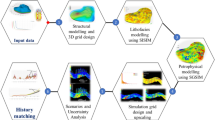Abstract
During exploration and pre-feasibility studies of a typical petroleum project many analyses are required to support decision making. Among them is reservoir lithofacies modeling, preferably using uncertainty assessment, which can be carried out with geostatistical simulation. The resulting multiple equally probable facies models can be used, for instance, in flow simulations. This allows assessing uncertainties in reservoir flow behavior during its production lifetime, which is useful for injector and producer well planning. Flow, among other factors, is controlled by elements that act as flow corridors and barriers. Clean sand channels and shale layers are examples of such reservoir elements that have specific geometries. Besides simulating the necessary facies, it is also important to simulate their shapes. Object-based and process-based simulations excel in geometry reproduction, while variogram-based simulations perform very well at data conditioning. Multiple-point geostatistics (MPS) combines both characteristics, consequently it was employed in this study to produce models of a real-world reservoir that are both data adherent and geologically realistic. This work aims at illustrating how subsurface information typically available in petroleum projects can be used with MPS to generate realistic reservoir models. A workflow using the SNESIM algorithm is demonstrated incorporating various sources of information. Results show that complex structures (e.g. channel networks) emerged from a simple model (e.g. single branch) and the reservoir facies models produced with MPS were judged suitable for geometry-sensitive applications such as flow simulations.




















Similar content being viewed by others
Notes
RedHat Linux 5.5 64-bit running in a HP Z800 workstation with 12 Intel Xeon X5680 3.33 GHz cores; 12.3 MB total CPU cache; 64 GB of RAM.
References
Armstrong A, Galli AG, Le Loc’h G, Geffroy F, Eschard R (2003) Plurigaussian simulatations in geosciences. Springer, Berlin
Arpat GB (2004) SIMPAT: stochastic simulation with patterns. Stanford Center for reservoir forecasting annual report
Avseth P, Mukerji T, Mavko G (2005) Quantitative seismic interpretation. Cambridge University Press, Cambridge
Boisvert JB, Manchuk JG, Deutsch CV (2009) Kriging in the presence of locally varying anisotropy using non-euclidean distances. Math Geol 41:585–601
Caers J, Avseth P, Mukerji T (2001) Geostatistical integration of rock physics, seismic amplitudes and geological models in North Sea turbidite systems. In: SPE ATCE Proceedings, number SPE 71321. Society of Petroleum Engineers
Caers J, Strebelle S, Payrazyan K (2003) Stochastic integration of seismic data and geological scenarios: A West Africa submarine channel saga. The Leading Edge, pp 192–196
Carvalho, PRM (2015) Modelagem Faciológica de Reservatórios Petrolíferos de Morfologia Intricada com Geoestatística Multiponto. MSc thesis. Universidade do Rio Grande do Sul, Porto Alegre, RS, Brazil
Chilès J, Delfiner P (1999) Geostatistics: modeling spatial uncertainty. Wiley, NewYork
Chopra S, Marfurt KJ (2007) Seismic attributes for prospect identification and reservoir characterization, vol 11. Society of Exploration Geophysicists, Tulsa, Oklahoma
Cox TF, Cox MAA (2001) Multidimensional scaling. Chapman & Hall/CRC, NewYork
Deutsch CV (2002) Geostatistical reservoir modeling. Oxford University Press, New York
Deutsch CV, Journel AG (1998) GSLIB: geostatistical software library and user’s guide. Oxford University Press, New York
Dewan JT (1983) Essentials of modern open-hole log interpretation. PennWell Books, Tulsa
Goovaerts P (1997) Geostatistics for natural resources evaluation. Oxford University Press, New York
Guardiano FB, Srivastava RM (1993) Multivariate geostatistics: beyond bivariate moments. In: Soares AO (ed) Proceedings of Geostatistics Tróia 1992. Springer, Netherlands, pp 133–144
Harding A, Strebelle S, Levy M, Thorne J, Xie D, Leigh S, Preece R (2005) Reservoir facies modeling: new advances in MPS. In: Leuangthong O, Deutsch CV (eds) Geostatistics banff 2004. Springer, Dordrecht, pp 559–568
Journel A (2002) Combining knowledge from diverse sources: an alternative to traditional Data independence hypotheses. Math Geol 34(5):573–596
Kenter JAM, Tankersley T, Skalinski M, Harris P, Levy M, Dickson T, Jacobs G (2010) Tengis field (Republic of Kazakhstan) Unit 1 platform static model: using a hybrid depositional-diagenetic approach. In: 2010 SPE reservoir characterization and simulation conference procedings, number SPE 139935. Society of Petroleum Engineers
Koltermann CE, Gorelick SM (1996) Heterogeneity in sedimentary deposits: a review of structure-imitating, process-imitating, and descriptive approaches. Water Resour Res 32(9):2617–2658
Krishnan S (2004) Combining individual data information: a review and the tau model. Stanford Center for Reservoir Forecasting Annual Report
Liu Y (2006) Using the Snesim program for multiple-point statistical simulation. Comput Geosci 32:1544–1563
Mariethoz G, Caers J (2015) Multiple-point geostatistics: stochastic modeling with training images. Wiley, Malaysia
Mariethoz G, Renard P, Straubhaar J (2010) The direct sampling method to perform multiple-point geostatistical simulations. Water Resour Res 46:W11536
Matheron G, Beucher H, Fouquet C, Galli A, Guerillot D, Ravenne C (1987) Conditional simulation of the geometry of fluvio-deltaic reservoirs. In: SPE ATCE Proceedings, SPE 16753. Society of Petroleum Engineers
Nichols G (2009) Sedimentology and stratigraphy. Wiley, London
Parra A, Ortiz JM (2011) Adapting a texture synthesis algorithm for conditional multiple point geostatistical simulation. Stoch Env Res Risk Assess 25:1101–1111
Remy N, Boucher A, Wu J (2009) Applied geostatistics with SGeMS: a user’s guide. Cambridge University Press, Cambridge
Strebelle S (2002) Conditional simulation of complex geological structures using multiple-point statistics. Math Geol 34:1–22
Strebelle S, Payrazyan K, Caers J (2002) Modeling of a deepwater turbidite reservoir conditional to seismic data using multiple-point geostatistics. In: SPE ATCE Procedings, number SPE 85962. Society of Petroleum Engineers
Tahmasebi P, Hezarkhani A, Sahimi M (2012) Multiple-point geostatistical modeling based on the cross-correlation functions. Comput Geosci 16:779–797
Zhang T, Switzer P, Journel AG (2006) Filter-based classification of training image patterns for spatial simulation. Math Geol 38:63–80
Acknowledgments
The authors thank Petrobras S.A. for supporting the development of this work.
Author information
Authors and Affiliations
Corresponding author
Appendices
Appendix 1: Python script to categorize values

Appendix 2: Python script used to convert the secondary data into facies probabilities

Rights and permissions
About this article
Cite this article
de Carvalho, P.R.M., da Costa, J.F.C.L., Rasera, L.G. et al. Geostatistical facies simulation with geometric patterns of a petroleum reservoir. Stoch Environ Res Risk Assess 31, 1805–1822 (2017). https://doi.org/10.1007/s00477-016-1243-5
Published:
Issue Date:
DOI: https://doi.org/10.1007/s00477-016-1243-5




